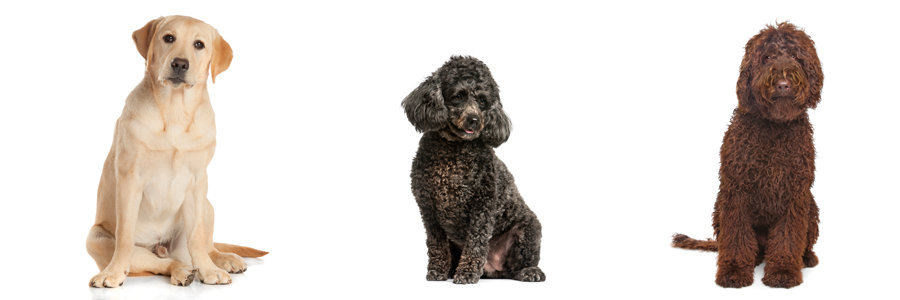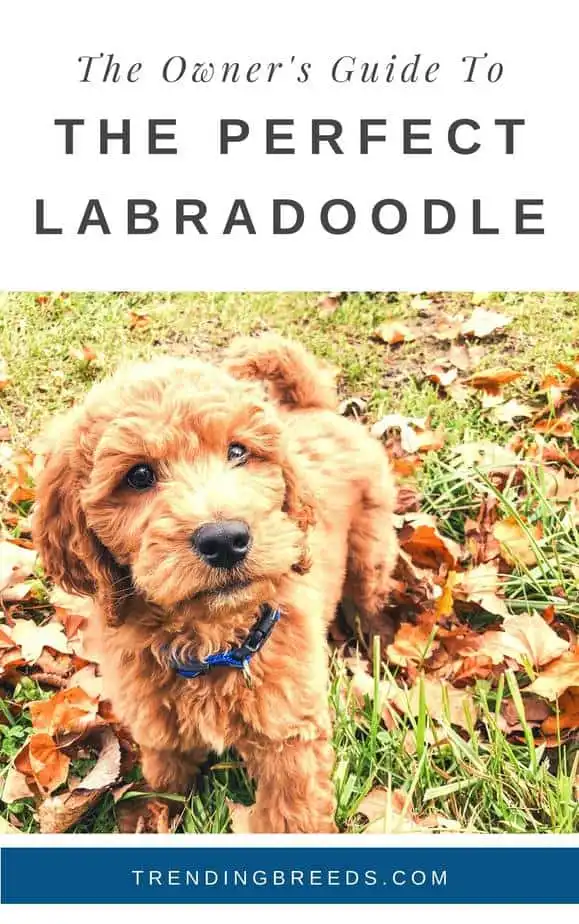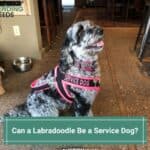
Labradoodles, which are a unique breed of dog created by mixing Poodles with Labrador Retrievers, offer potential owners choices regarding size, color, and coat through the use of multi-generational breeding.
So, what is a Multi-Generational Labradoodle? A multi-generational Labradoodle is one whose parents are BOTH Labradoodles. Labradoodles can be the result of various generations of breeding different Poodle/Labrador combinations. Labradoodles start as what is known as the P-generation; a purebred Poodle and purebred Labrador. Their offspring classified as one of the following:
- F1 or First Cross Generation: 1 Poodle + 1 Labrador Retriever parent
- F1b or Back Cross Generation: 1 Poodle + 1 F1 or a Multi-generational Labradoodle parent
- F2 Generation: (2) F1 Labradoodle parents
- F2b Generation: 1 F1 Labradoodle + 1 F1b Labradoodle parent
- F3 Generation: (2) F2 Labradoodle parents
- Multi-Generation: (2) F3 Labradoodle parents
Breeders often spend extensive time studying the pedigree of their dogs to create precisely the right Labradoodle.
Creating just the right Labradoodle involves more than just producing puppies that are cute.
Knowing what the different classifications indicate can help owners familiarize themselves with what the breeders are offering and can be beneficial when shopping and/or buying a Labradoodle.
After all, knowledge is power, right? Arming yourself with information is actually one of the first and best things you can do for your dog.
If you’re serious about bringing a Labradoodle into your life, be sure to pick up your copy of our latest book, The Owner’s Guide To The Perfect Labradoodle.
New owners are often full of questions and struggle with confidence when raising their puppy.
This book will not only address all of your concerns but will also give you practical tips that you can implement with confidence to raise the best dog ever.
What topics are covered? You name it, it’s in there:
- Working with a breeder or adopting.
- Puppy proofing.
- Housebreaking and crate training.
- Obedience and reward-based training.
- Temperament and physical features.
- Proper exercise guidelines.
- Mental stimulation and socialization.
- Nutrition and health.
- Recommended toys, tools, and supplies.
- Shedding and grooming.
The best thing about this book is that it is based off of my actual experience with Labradoodles.
It’s not some run-of-the-mill, apply-to-any-breed book. It’s written specifically for Labradoodles by a Labradoodle owner/lover (me).
Breed-specific, to the point, and easy to follow, this will be the only Labradoodle book you need.
As an owner of 2 Labradoodles myself, I know how tough it can be to find good information. In the 60+ pages of this book, I share the information, resources, and breed-specific tips I wish I’d had from the start. You will save you time, money, and loads of frustration…take my word for it!
Important Factors In Each Generation
Labradoodles are adorable, friendly, and intelligent dogs, and many people buy Labradoodles because of one or all of these qualities.
However, some people choose this breed because of their reputation for not shedding much and for being somewhat hypoallergenic.
Surprisingly enough, the more fur the Labradoodle has, the less the dog will shed.
(You can find more details about Labradoodle shedding here.)
Allergies can be a big issue for many people. It’s often the main reason why many dog lovers choose not to have a family dog.
Although many people mistakenly believe it’s dog fur that causes allergies, it’s usually the dog’s dander.
Allergy sufferers often choose the Labradoodle. Different generation Labradoodles have different dander and coat characteristics.
Generally, the further down the generational ladder you get, the less dander and allergy problems you’ll see.
Multi-generational Labradoodles are usually the best for allergy and asthma sufferers.
People who do not suffer from allergies can choose a Labradoodle from any generation and base their choice on color, coat, or size.
Note: Regardless of coat type and generation, Labradoodles will need to be groomed routinely.
P-Generation
You may hear the phrase “P-Generation” in reference to the generation of Labradoodles. It’s almost the same as the phrase “F1 Generation.”
The P-Generation is the start of any generational breeding program and involves mating Purebred A (Labrador) with Purebred B (Poodle).
The resulting puppies are the first generation of Labradoodles.
Here are the different generations of Labradoodles that can lead up to a multi-generational Labradoodle.
F1 (First Cross)
Puppies that are said to be F1 are the result of the mating of a Standard Poodle parent with a Labrador Retriever parent.
Because the Poodle and Labrador Retriever are so different in appearance, the puppies may exhibit various traits.
In addition to having different color options, their coats may also vary in thickness, texture, and length.
Some of the puppies, due to their coats, may have more or less shedding or non-shedding attributes. Due to certain inconsistencies in the breed line, some breeders do not breed F1 puppies.
F1b (Back Cross)
The F1b is a puppy that has one parent that’s a Poodle and another parent that’s either an F1 (First Cross) or a Multi-generational Labradoodle.
F1b puppies usually have coats that are non- to low-shedding. The F1b is 75% Poodle and 25% Labrador Retriever.
F2 Generation
The F2 Labradoodle is a combination where both parents are F1 Labradoodles. The puppies are 50% Poodle and 50% Labrador Retriever.
F2b Generation
The F2b Labradoodle is a combination where one parent is an F1 Labradoodle, and the other parent is an F1b Labradoodle. The puppies are 75% Poodle and 25% Labrador Retriever.
F3 Generation
The F3 Generation Labradoodle is a combination of two F2 hybrid parents. The puppies are 50% Poodle and 50% Labrador Retriever.
Multi-Generational Labradoodles
Also known as Multigen, these are the result of the breeding of two F3 Generation Labradoodles. In other words, both parents must be Labradoodles.
Multi-generational Labradoodles are considered the “cream of the crop” by breeders and are the result of generations of breeding expertise and time.
Many breeders prefer multi-generational Labradoodles because of the consistent results in the puppies.
- Excellent temperament (5 traits that make them popular found here)
- Attractive appearance
- Consistent, high-quality coats
- Allergy-friendly
- Non-shedding
- Loving and affectionate
Multi-Generational Labradoodle Coats
Although there are many reasons why breeders enjoy multi-generational Labradoodles, one of the main reasons is the coat.
Through a lot of research, practice, and trial-and-error breeding, they’ve managed to combine the best qualities of each dog to get the perfect puppies with the best coats.
Many adjectives have been used to describe the Labradoodle’s coat, but the multi-generational Labradoodle only has two true coat types: fleece or wool.
- Fleece – The soft and silky fleece coat has waves and curls, although the number of waves and curls can vary. The fur on a fleece coat will flow and ripple when the dog moves around. Wavy fleece hair can grow 4 to 6 inches long. Because these dogs don’t shed, the hair must be clipped or manually pulled out when the dog changes from pup to adult.
- Wool – This coat, if not trimmed, will become thick and dense with tight, soft round curls. Unlike the fleece coat, this fur does not move around with the dog’s movement. Labradoodles with wool coats should be trimmed a few times a year.
Recommended Grooming Tools:
- Slicker brush – This type of brush is ideal for daily brushing as it gets the job done without being too harsh on the coat. My favorite self-cleaning slicker brush works through tangles quickly and easily and releases hair with the push of a button.
- Comb – A steel, dual-sided comb, like the one I use, gets all the way down to the skin to prevent mats from forming – great for all Doodle dogs.
- Dematting comb – This is perfect to have on hand for when the inevitable mats do occur. It makes short work of removing mats without cutting out large chunks of fur. I personally use and recommend this one on Amazon.
You’ll likely add to this list as time goes on, but at the beginning, the above tools are a nice start.
If you’d like to get everything you’ll need for DIY grooming now, head over to our Guide to Grooming Supplies.
What fleece and wool coats both have in common:
- The absence of dog odor
- Naturally dirt repellent if bathed regularly
- Both come in various colors
Years of experienced generational breeding have resulted in more options than ever before for Labradoodle lovers.
In addition to the basic colors, Labradoodles may also come in rare colors like merle, sable, or black-tipped varieties. Some common color choices include:
- Chocolate
- Caramel
- Red
- Chalk
- Gold
- Apricot
- Black
- Blue
- Parchment
- Multi-patterned
If you’d like to learn more about the coat types, how they feel, and what colors they come in, we’ve put that all together in this article here.
Our favorite tips for grooming your Labradoodle can be found here.
Advantages of Multi-Generational Labradoodles
Labradoodle breeders usually choose multi-generational breeding as a way to not just improve on the breed but also for the consistency in their litters.
They’ve chosen this breeding method because it allows them to “mix-and-match” the parents with the best qualities, including coat, temperament, size and intelligence.
The puppies coming from these parents are generally sociable, gentle, non-aggressive, intuitive and highly intelligent.
They have the qualities needed to make excellent service or therapy dogs. (See this article to find out why.)
One of the main advantages of multi-generational Labradors is that the breeders have had years of breeding these dogs through several generations, so their results are not coincidental or random.
They’re able to focus on the dog’s bloodline regarding temperament, health, coat, trainability, and even coat quality.
How easy are they to train exactly? We answer that here.
The coat quality and style may not seem important to one individual but can make a huge difference to an individual suffering from allergies.
Parents have often commented on how each of their children is different, and they often wish they could take the best qualities of each child and combine them for the perfect child.
Not that there is a “perfect child”, but this is almost what a Multi-generational Labradoodle breeder does when choosing the sire and dam.
Your Labradoodle’s generation is really only a small part of who they are. The way in which you raise and train your pup can influence their personalities a great deal.
As with everything, there’s a right way and a wrong way to go about it.
In The Owner’s Guide To The Perfect Labradoodle, I show you the best techniques for ensuring that you and your dog get off to the best start possible.
From what to do before you even bring your pup home to expert tips on training and grooming – it’s all covered in this easy-to-read, information-packed book.
Grab your copy today to be on your way to transforming your puppy into your dream dog.
Related Questions:
Are Multi-Generational Labradoodles really better?
It’s not so much a matter of being better as being more appropriate.
Because the breeders are taking generations of characteristics from their best dogs, the results are high-quality Labradoodle puppies that are ideal for different situations, whether it’s for a family pet, to be trained as a service dog, or just an allergy-free, low-shed companion dog.
Are Multi-Generational Labradoodles more expensive?
When it comes to the price for these dogs, you really do get what you pay for. (See actual price examples here.)
There are many wonderful Poodles, Labrador Retrievers, and Labradoodles around, and many of them are probably very affordable.
But, how much do you really know about the dog’s heritage and ancestry? With a multi-generational Labradoodle, you’re provided with the information you need.
Do Multi-Generational Labradoodles have longer lifespans?
Labradoodles do have some health issues but are generally healthy dogs overall with lifespans of 12 to 15 years.
Although they are the result of generations of careful breeding, there are still some health issues that both Poodles and Labs are prone to developing.
If you’re considering buying a Labradoodle, it’s important to check on the health of the parents and make sure your dog gets regular checkups from your veterinarian.
We Hope You Enjoyed!
If you’re a Labradoodle lover who has been considering getting a Labradoodle, this overview hopefully gives you all the information you need to make an informed decision regarding this exciting breed.
Whether you’re a single individual or part of a family, you’ll find Labradoodles make an excellent choice for a pet, service dog, or lifetime companion.
Find more detailed information, answers to specific problems, and fun facts in our many other Labradoodle articles.





